Dr Edmond Smith, research fellow at the PEIC, reveals the results of his study into what makes people in insurance want to innovate, and what experiences they draw from to do it

Learn more about Dr Edmund Smith and the Centre for the Study of the Political Economies of International Commerce (PEIC) here
In April last year, I had the great pleasure of attending the Insurance Times Innovation & Disruption conference. We explored some fascinating topics – the demonstration of a flying drone building 3D-printed homes in disaster zones was a particular highlight – but the rush to next-gen tech-utopias wasn’t quite matched by the insurers in the room.
While they were excited by the latest innovations, they were acutely aware of the challenges they face: keeping up with the latest technological changes while serving customers brilliantly in the here-and-now is a difficult one to balance.
Does the industry have the right people for the job?
Achieving real change, which will benefit customers and businesses alike, will require the industry to embrace innovative ideas, processes and systems, but does it have the right people for the job?
As an academic, I’m interested in cultures of innovation and the ways networks transmit and shape ideas, so the attendees at this event were just as interesting to me as what was happening on stage.
As a microcosm of the industry they offer a great opportunity to analyse the demographics of innovation. They came from a range of backgrounds, roles and time served in insurance, but were all present because they shared an interest in innovation.
Methodology
247 of the attendees had LinkedIn profiles, and the information shared there was the basis for my analysis. My interest was less in what they’re doing now and more in how they’d reached their current positions – what is it that makes them want to innovate and what experiences can they draw upon to do it?
Innovation depends on new ideas, new arguments, and new ways of looking at old questions, and at the moment, insurance still struggles with this
Their experiences show one of the greatest strengths of the insurance industry, stability, alongside what is probably its biggest challenge: stagnation. Innovation depends on new ideas, new arguments, and new ways of looking at old questions. It demands diversity of opinion and is built on the diverse experiences of people brought together through shared visions of what could be. And at the moment, insurance as a whole still struggles with this.
From space to sea
Analysing the experiential networks of the Insurance Times Innovation & Disruption attendees reveals some striking patterns about insurance innovation.
The average attendee graduated in 1999 – making them at least 38 years old – and in their 17 years of work will have joined 4.3 companies, staying with each for almost four years before moving on to pastures new. They’d worked in roles ranging from distribution and underwriting to the Royal Marines and working on space ships!
Over the course of their careers 161 of the attendees had worked in insurance, 45 in other financial roles, 48 in technology, 63 as consultants, 45 in marketing, 27 in project management and 32 in sales. Clearly, finding that the most common experience was in insurance isn’t entirely surprising. However, experiences outside insurance were fairly common too:
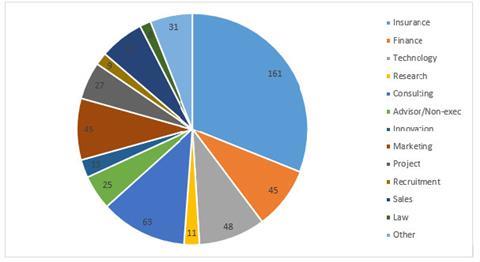
Unfortunately, it’s not really the case that diversity of experience, that key ingredient in innovation, is easy to find in insurance.
While the event was a great means of connecting people with different experiences, most of the attendees were very unlikely to have moved function during their careers.
Certain types of experiences are kept in certain departments, often with little interaction or means to exchange ideas
Marketing expertise leads to more jobs in marketing, experience in sales lends itself to sales roles, and so on. On an individual level, this makes absolute sense, but in a big organisation, it can stifle innovation.
Certain types of experiences are kept in certain departments, often with little interaction or means to exchange ideas. Even the senior players in companies are likely to have deep experience in only a single field: most insurance executives have always been insurance executives.
Understanding network analysis
The application of network analysis tools, which I’ve been developing since the start of my PhD, visualises some of the challenges:
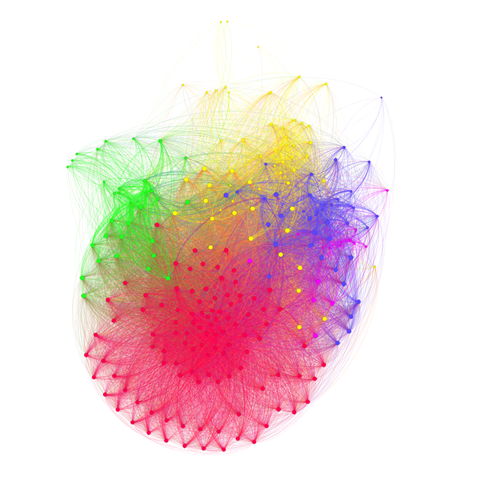
Each attendee is shown as a coloured node and the connections between them (edges) represent a shared experience.
The algorithm that made this graph pulls people together into groups depending on how well they are connected. Nodes with a greater influence in the network are found both through the number of shared relationships they have but also ranks these through the importance of other clusters across the network.
When this is done, the shared experiences of the event attendees are quite starkly divided between different communities (clusters) within the wider network. The large red cluster represents people with predominantly insurance experience, green marketers, yellow consultants and blue technology experts.
The fairly loose graph density, coupled with limited numbers of individuals stepping across different experiential community, demonstrates the ongoing challenges in bringing talented individuals together whose expertise and specialities can be integrated through a shared language and understanding of the industry.
This has serious repercussions for innovation in insurance – where will the innovation come from?
How AXA and Aviva stand out
One solution, clearly adopted by AXA and Aviva in the event sample, is to employ younger staff with diverse experiences in dedicated innovation teams. Looking at people who graduated in 2008 or later, the length of time spent at each company is almost half that of the overall sample.
Plus, 87.5% of these younger attendees have held a role in a non-insurance company and only 62.5% had worked for an insurer. Their insurance role was generally their most recent role; they were brought in because they could bring new skills and ideas.
These attendees had spent less time each role and had a greater propensity for stepping across different types of roles – say from marketing into technology into consulting into insurance – giving their final employer a much broader set of experiences to draw on in innovation projects.
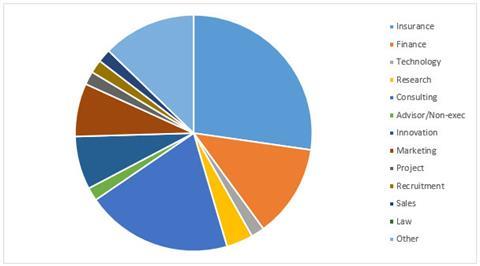
Further analysis of the younger attendees shows how experiences cross between different individuals.
The younger network is much more balanced
While the overall picture shows experienced insurance professionals only loosely connected with peripheral communities, the younger network is much more balanced. The lack of peripheral clusters highlights that the individuals included in this smaller network have held varied roles (see image below).
While the same algorithm has been used to determine two coloured groups – those with insurance experience are red, those without blue – there are extensive connections between the two. Insurance is not the dominant experience.
Younger members of this sample are much more likely to enter the insurance industry with a wider range of experience and to swap between different specialisms during their career:
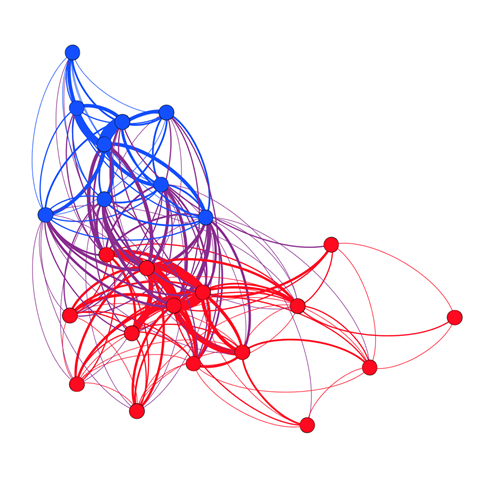
In practice, this dynamic is already proving highly successful. Aviva, who won Insurance Times Innovation Award in 2015, are the clear winners within this sample.
Not only do they seem to have had particular success in hiring a diverse team of younger staff, but their global digital innovation director is also one of the most influential figures within the entire network.
With a range of experiences from across different industries, Aviva is creating an environment where innovation in insurance is being reached through the effective sharing of ideas and approaches to work.
Insurance businesses are trying to break down the barriers that stymie innovative thinking and practice
The most successful innovators can connect the dots across different disciplines and diverse experiences within the workforce are incredibly helpful in achieving this. In innovation, collaboration is king, and across the whole industry, big strides have been made in developing innovation programmes that take this on board.
Both internally and through relationships with external organisations, insurance businesses are trying to break down the barriers that stymie innovative thinking and practice. In doing so, the industry is becoming more diverse and more aware of the possibilities – but the links drawing people together to create an innovative nexus remain fragile.





























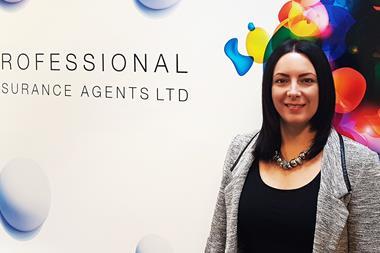
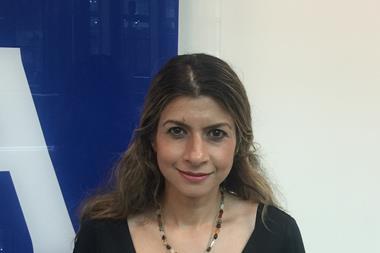
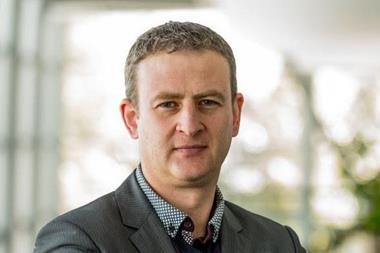

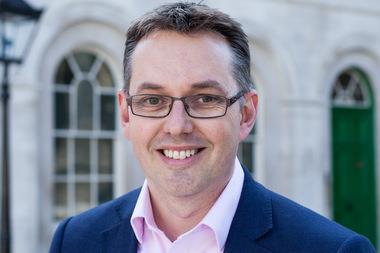




No comments yet